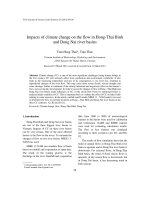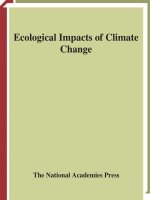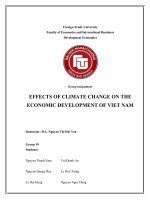slide the impacts of climate change to mekong delta realities and solutions
Bạn đang xem bản rút gọn của tài liệu. Xem và tải ngay bản đầy đủ của tài liệu tại đây (3.93 MB, 49 trang )
THE IMPACTS OF CLIMATE CHANGE TO
MEKONG DELTA:
REALITIES AND SOLUTIONS
LE QUANG TRI
Research Institute for Climate change – Can Tho University
1
MEKONG DELTA’S SCENARIOS
Mekong delta is the largest agriculture and aquaculture area at Vietnam (2.4
million Hectares of agricultural area/ 4 million Hectares of total)
Supply 50% of Rice, 65% of aquatic and 75% of Fruit for the whole country.
Exporting 7 million tons of Rice to the world in 2011.
A vulnerable area because most
people are living along the sea
with the elevation under 10 meters
(LECZ)
Sea level
rise (m)
Losing
Land (%)
Relocated
population (%)
# 1.0
# 25
# 20 (3.5 mil.)
# 2.0
# 50
# 75 (14 mil. )
(Nhân, 1997)
Considered one of the wetlands of Vietnam with flat terrain, the ground is low.
Very high biological diversity, sensitive in ecological characteristics. (Tuan
and Wyseure, 2007)
4
A
A
Biên giới
3.00
VN-CPC
2.00
1.00
A-A
Đồng
Tháp
Tiền
Giang
Sông
Tiên
Đồng
Tháp
Sông
Hậu
Cần Sóc
Bac
Tho Trăng Liêu
0.00
- 1.00
- 2.00
Không
theo tỉ lệ
- 12 - 15 m
- 15 - 20 m
Biển
T.1
T.3
T.3
T.2
T.4
T.5
Dry season
T.6
T.7
T.8
T.9
T.10
T.11
T.12
Dry season
Rainy season
Hè Thu
Đông Xuân
Đông Xuân
Thu Đông
Rau màu
Rau màu
Rau Màu
Tôm - Lúa
Lúa Cá
Lúa cá
Coastal areas
Flooded areas
Forecast figures for
the climate change
is simulated by
ECHAM4 model
with gas emission
scenario A2 and
the details using
PRECIS model with
high resolution.
Results from climate models, then regional hydrological simulation
modeling ocean rotation is integrated into a hydrodynamic model, EIA 3D
model, is helpful for preventing flooding at Mekong Delta.
Climate change forecast in the Mekong Delta
Average maximum temperature in 1980s và 2030s (anticipation)
Average minimum temperature in 1980s và 2030s (anticipation)
Climate change at Mekong
Delta
The number of hot days per annum in 1980s và 2030s (anticipation)
Annual rainfall (mm) in 1980s và 2030s (anticipation)
Accumulated rainfall: Median year
(10.4 - 105.0 - An Giang)
2000.00
millimeter
1600.00
1200.00
800.00
400.00
0.00
0
30
60
90
120
150
180
210
240
270
300
330
360
390
Day
1980s
2030s
Range 1980s
Range 2030s
1st day >200mm 1980s
1st day >200mm 2030s
Accumulated rainfall: Median year
(10.8 - 105.4 - Can Tho)
2000.00
millimeter
1600.00
1200.00
800.00
400.00
0.00
0
30
60
90
120
150
180
210
240
270
300
330
360
Day
1980s
Accumulated rainfall: Median year
(9.4 - 105.8 - Soc Trang)
Range 1980s
Range 2030s
1st day >200mm 1980s
- Later starting point of rainy
season,
2000.00
1600.00
1200.00
800.00
- lower annual rainfall
400.00
0.00
0
30
60
90
120
150
180
210
240
270
300
330
Day
1980s
1st day >200mm 2030s
In the future:
2400.00
millimeter
2030s
2030s
Range 1980s
Range 2030s
1st day >200mm 1980s
1st day >200mm 2030s
360
390
390
Change in annual rainfall in 2030s (anticipation)
Flood area at Mekong Delta in 1980s and 2030s (simulation)
15
(Nguồn: SIWRP, 2008)
In dry season, salty will penetrate deeper corresponding
to sea level rise.
Speculation in the 2030s: about 1.5 to 2.0% of the area
being flooded by rising sea levels.
16
The trend of Climate and other disasters change at Mekong Delta
over the next 3 decades
Weather factors
Source: Tuấn, 2010
Trend
Major influenced areas
Nhiệt độ max, min, trung bình mùa khơ
An Giang, Đồng Tháp, Long An, Cần Thơ,
Sóc Trăng, Kiên Giang
Số ngày nắng nóng trên 35C mùa khô
Các vùng giáp biên giới với Cambodia,
vùng Tây sơng Hậu
Lượng mưa đầu mùa (tháng 5, 6, 7)
Tồn đồng bằng SCL
Lượng mưa cuối mùa (tháng 8, 9, 10)
Các vùng ven biển ĐBSCL
Lốc xốy – gió lớn – sét
Các vùng ven biển, hải đảo ĐBSCL
Mưa lớn bất thường (> 100 mm/ngày)
Các vùng ven biển bán đảo Cà Mau, vùng
giữa sông Tiền và sông Hậu
Áp thấp nhiệt đới và bão ven biển
Các vùng ven biển bán đảo Cà Mau, vùng
giữa sơng Tiền và sơng Hậu
Lũ lụt (diện tích ngập và số ngày ngập)
Vùng Tứ giác Long Xuyên – Hà Tiên,
vùng Đồng Tháp mười, vùng giữa sông
Tiền và sông Hậu
Nước biển dâng - Xâm nhập mặn
Các tỉnh ven biển
Sạt lở
Các tỉnh ven biển, vùng giữa sông Tiền
và sông Hậu
Tác động của triều cường
Toàn đồng bằng
Sự thay đổi mực nước ngầm
Toàn đồng bằng
17
Reality and impact
of Climate Change
18
"Over 10 years, climate change has become one of the most
concerning economic issues - social and environment in the
world ..."
Intergovernmental Committee on Climate Change has indicated
that Mekong Delta in Vietnam is one of three deltas affected the
most by global climate change (IPCC 4th Assessment Report,
2007).
The impact of climate change
T.1
T.2
T.3
T.4
T.5
T.6
Hạn đầu vụ
Khơ nóng
T.7
T.8
Hạn Bà
Chằn
T.9
T.10
T.11
T.12
Lũ cao
Lũ sớm
Thiếu
nước
Nước phèn
Bão
Xói lở
Nhiễm mặn
Gió chướng
Sét
Mưa + Triều cường
Lạnh
River flows change
-
-
-
River Basin at MD about 64 300 km²
in VN, with flow around 53,000
million m3
Water dragging and retaining
decrease due to
20-yeardeforestation, which in turns causing
flooding in rainy season and water
shortage in dry season.
Deforestation soil erosion flowing
into the Sea Lake, causing lake
capacity reduction, water flows
directly into Hau and Tien rivers
floods
Flooding
-
Periodic flooding
Mekong Delta
in
the
-
The peak flooding occurs
when the Tien river level at
Tan Chau > 4.2 m and the
water level in the Hau River in
Chau Doc > 3.5 m
-
Prediction:
Mekong
flow
increased 10% during the
flood season (in Sept and
Oct), so flooding in the Delta
could be worse, come sooner
and last longer than today.
Flood area at MD from 1998 to 2000 and
in 2004
1998
2000
2004
23
Mekong Delta
... From "Living with Floods"
... To "Living with Climate Change"
24
THE IMPACTS OF CLIMATE CHANGE
• The abnormal weather
phenomena is increasing
more and more frequent.
• The natural disasters
and severe weather
conditions (floods,
droughts, tornadoes,
lightning, floods, waves,
...) are increasing the
intensity and locations









